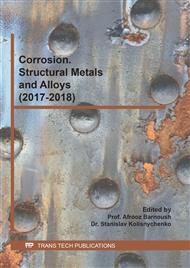p.1194
p.1200
p.1207
p.1213
p.1220
p.1226
p.1233
p.1239
p.1245
Thermal Desorption Spectroscopy Study on the Hydrogen Behavior in a Plasma-Charged Aluminum
Abstract:
Hydrogen in aluminum has been known to be the cause of blister and pore. Some aluminum alloy is susceptible to stress corrosion cracking, which is based on intergranular cracking arisen from hydrogen embrittlement. The behavior of hydrogen in aluminum has not been fully understood yet. Hydrogen gas plasma enables to introduce high hydrogen concentrations into specimen without Al (OH)3 layer on the surface of specimen. In this paper, we have investigated the behavior of hydrogen in a plasma charged aluminum by means of thermal desorption spectroscopy, a method to evaluate the amount and trap states of hydrogen. Cold-rolled pure aluminum were annealed, electro-polished and charged with hydrogen gas plasma. Immediately after hydrogen gas plasma charging, TDS tests were performed under ultra-high vacuum. The hydrogen desorption spectrums obtained by TDS tests had three peaks corresponding to the co-diffusion of hydrogen-vacancy pair, dislocation and pore. Compared to a sample without charging, in a plasma charged sample, the amount of hydrogen trapped in vacancies especially increased.
Info:
Periodical:
Pages:
1220-1225
Citation:
Online since:
November 2016
Authors:
Keywords:
Price:
Сopyright:
© 2017 Trans Tech Publications Ltd. All Rights Reserved
Share:
Citation:



